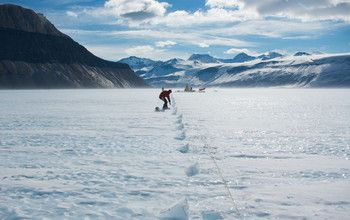Krypton Used To Date 120,000-Year-Old Antarctic Ice, New Technique Takes Us ‘Further Back In Time’

Scientists have found a new way to date Antarctic ice that may give a clearer history behind climate change on Earth.
A 120,000 year-old piece of Antarctic ice was dated using krypton rather than carbon dating. Krypton, a noble-gas element, was found to be more reliable when it came to finding how old the ice is, although the process is extremely difficult. The findings, published this week in the Proceedings of the National Academy of Sciences, may be able to provide a more accurate picture of ancient ice ages.
"The oldest ice found in drilled cores is around 800,000 years old and with this new technique we think we can look in other regions and successfully date polar ice back as far as 1.5 million years," Christo Buizert, a researcher at Oregon State University, who is the study's lead author, said in a statement.
Reconstructing the world’s climate to 1.5 million years ago will help scientists understand how many ice ages there were and how long they lasted. The Earth is believed to have shifted in and out of ice ages every 100,000 years for the past 800,000 years. There's speculation that before that time, ice ages took place every 40,000 years. The new study may be able to confirm this theory.
"Why was there a transition from a 40,000-year cycle to a 100,000-year cycle?" Buizert said. "Some people believe a change in the level of atmospheric carbon dioxide may have played a role. That is one reason we are so anxious to find ice that will take us back further in time so we can further extend data on past carbon dioxide levels and test this hypothesis."
Krypton dating resembles carbon dating since it measures the decay of a radioactive isotope. But unlike carbon-14 dating, krypton is a noble gas that is stable and has a half-life of about 230,000 years. Carbon dating is less reliable when it comes to ice since the isotope is produced in the ice itself by cosmic rays.
While krypton dating has been used for more than 40 years, it was difficult since Krypton-81 atoms are so few and difficult to count. It was only in 2011 when a new detector technology was developed did Kyrpton-81 dating become accessible to the larger scientific community.
The latest study used the detector along with a new Blue Ice Drill that allowed scientists to collect ice samples. Scientists used several 660-pound chunks of ice, melted them, and collected their air bubbles to krypton date them.
"The only problem is that there isn't a lot of Krypton in the air, and thus there isn't much in the ice, either. That's why we need such large samples to melt down," Buizert said.
© Copyright IBTimes 2024. All rights reserved.






















